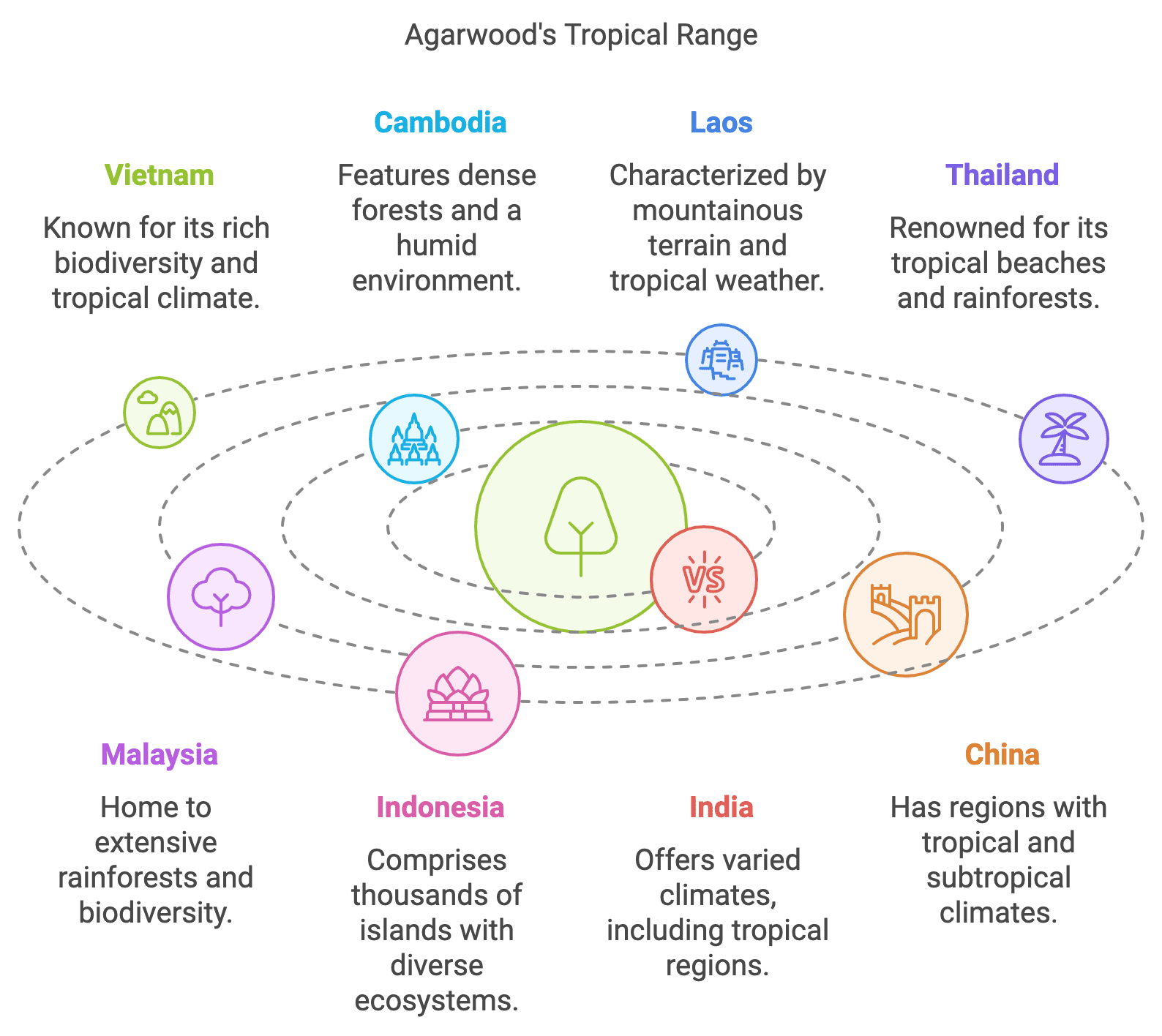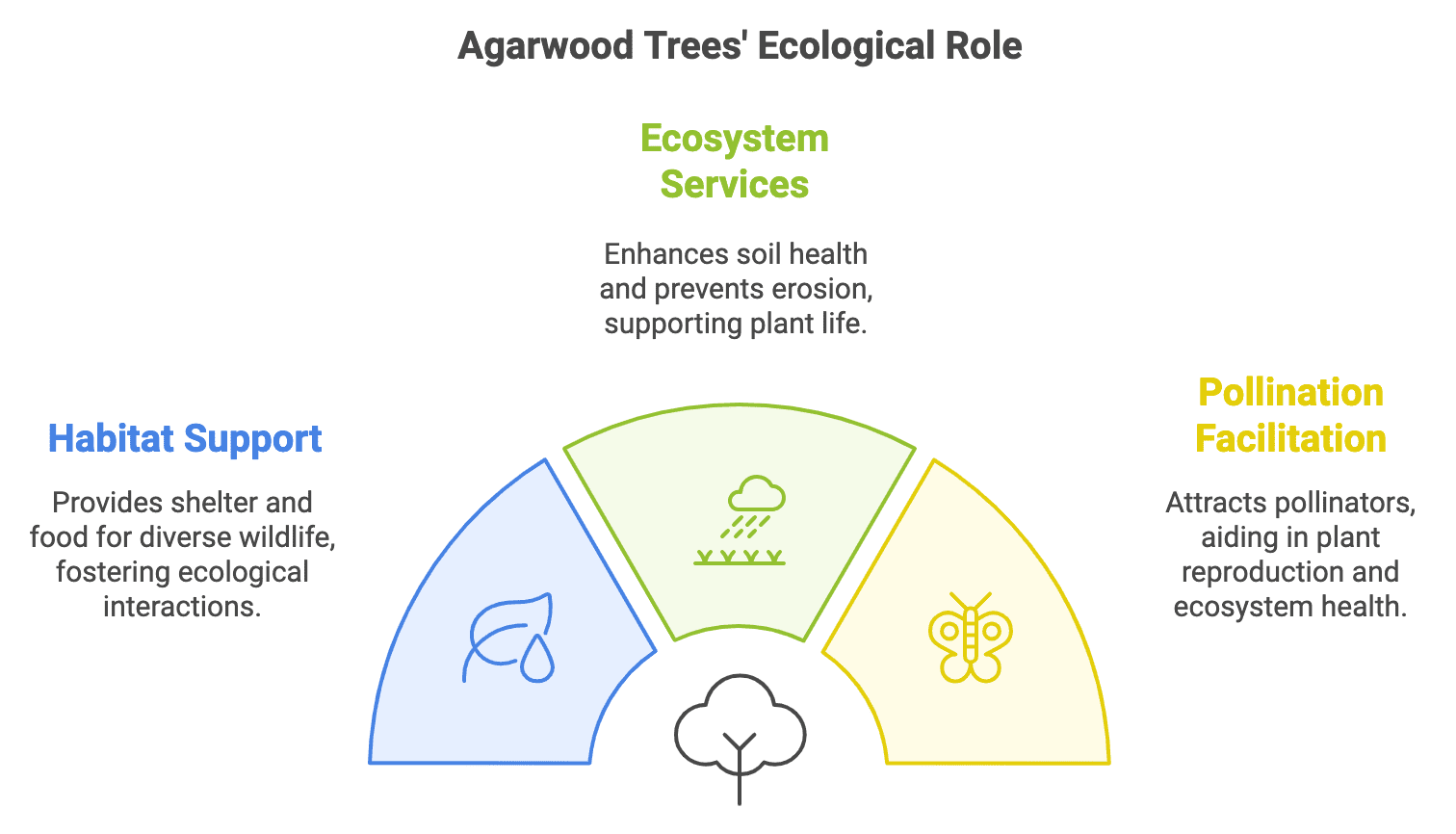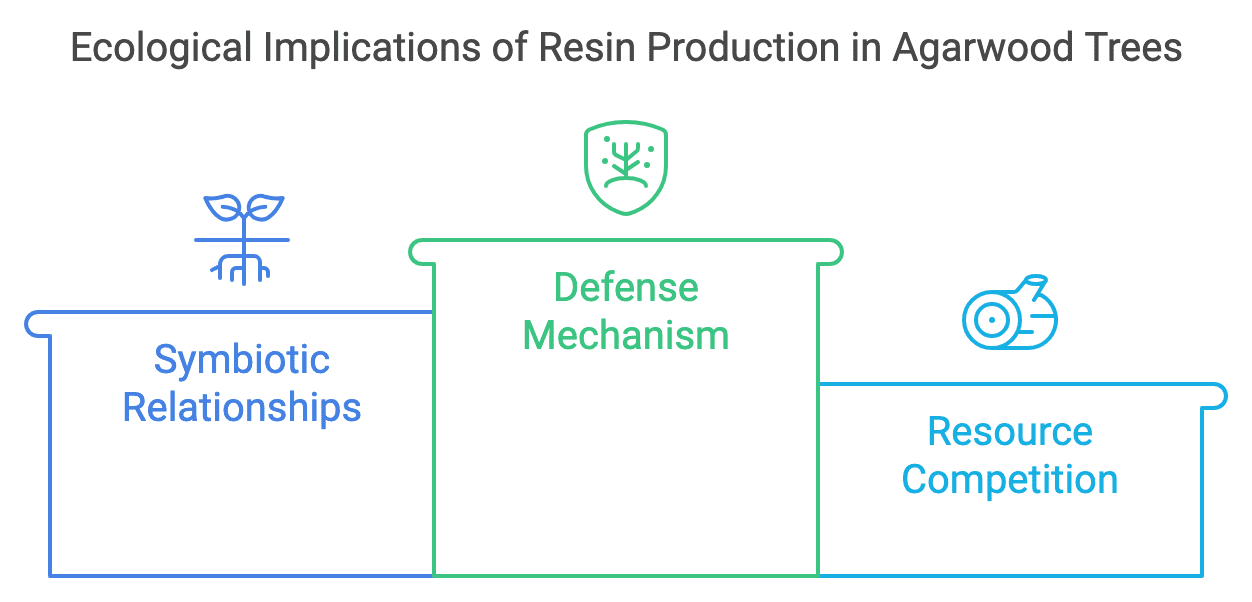
I. Introduction
Table of Contents
ToggleDid you know that agarwood trees can grow up to 40 meters tall and are essential for producing the highly prized agarwood resin? These rare and valuable wood species are integral to both economic sectors and ecological systems. Understanding the biological characteristics and taxonomic classification of agarwood trees is crucial for their sustainable management and conservation efforts.
As the demand for agarwood increases, it becomes vital to appreciate not only its economic significance but also its ecological contributions and the need for sustainable practices. Understanding the agarwood formation process is essential for developing effective sustainable cultivation and harvesting practices.

II. Biological Characteristics of Agarwood Trees
A. Species Overview
The Aquilaria species comprises several species known for producing agarwood, including:
- Aquilaria malaccensis
- Aquilaria crassna
- Aquilaria sinensis
These Aquilaria species are primarily found in Southeast Asia, thriving in tropical forests. Each species varies slightly in its resin production capabilities and fragrance profiles, contributing to the diversity of agarwood products available in the market. The differences in resin quality and yield among the species make certain types more desirable, further influencing market dynamics.

B. Morphological Features
Agarwood trees exhibit distinct morphological features that aid in their identification:
- Leaves: Typically glossy and evergreen, arranged alternately on the branches. The leaf structure helps in photosynthesis and contributes to the overall health of the tree.
- Bark: Smooth and pale when young, becoming rough and fissured with age. This bark protects the tree from environmental stressors and pests.
- Flowers: Small and fragrant, usually white or yellow, blooming sporadically. The flowers attract pollinators, which are essential for the reproduction of the trees.
- Wood: The heartwood is initially pale but darkens significantly due to resinous heartwood formation. The dark color and density of the heartwood are indicators of high resin content, which is crucial for its economic value.

These physical attributes not only make agarwood trees easily recognizable but also play a role in their ability to produce the coveted fragrant resin.
C. Habitat and Distribution
Agarwood trees are native to tropical regions with high humidity and well-drained soils. Their natural distribution includes:
- Vietnam
- Cambodia
- Laos
- Thailand
- Malaysia
- Indonesia
- India
- China

These trees prefer lowland rainforests but can also be found in montane forests where they adapt to varying altitudes and climatic conditions. The geographical spread of Aquilaria species is crucial for maintaining genetic diversity and ensuring the ecological balance within their habitats.
By thriving in diverse environments, agarwood trees contribute to the overall health of tropical ecosystems, supporting various flora and fauna. Understanding the biological traits aids in the sourcing of agarwood to ensure quality and authenticity.
III. Classification of Agarwood Trees
A. Taxonomic Classification
Understanding the taxonomic classification of agarwood trees helps in identifying and differentiating between species. The classification hierarchy is as follows:
- Kingdom: Plantae
- Clade: Angiosperms
- Clade: Monocots
- Order: Malvales
- Family: Thymelaeaceae
- Genus: Aquilaria
- Species: Aquilaria malaccensis, Aquilaria crassna, Aquilaria sinensis, etc.
The Aquilaria genus is closely related to the Gyrinops walla, both belonging to the Thymelaeaceae family. While Aquilaria species are primarily known for producing agarwood, Gyrinops species also contribute to the agarwood market, albeit less commonly. The classification of these species is vital for conservation efforts and understanding their ecological roles.

B. Genetic Diversity
Genetic diversity within Aquilaria species is essential for the resilience and sustainability of agarwood production. Recent genetic studies have focused on:
- Genetic markers: Identifying specific genes responsible for resin production. This research is critical for improving agarwood quality and yield.
- Population genetics: Understanding the genetic variation across different populations to inform conservation strategies. Maintaining diverse gene pools helps in adapting to environmental changes.
- Breeding programs: Developing selective breeding techniques to enhance resin yield and quality. This is essential for meeting market demands while ensuring ecological health.

Maintaining genetic diversity ensures that agarwood trees can adapt to environmental changes and resist diseases, thereby securing their role in both ecosystems and economies. Understanding the biological characteristics helps in identifying the different types of agarwood available in the market.
IV. Ecological Role of Agarwood Trees
A. Biodiversity Support
Agarwood trees play a crucial role in supporting biodiversity within their ecosystems:
- Habitat: They provide shelter and food for various wildlife species, including birds, insects, and mammals. The presence of these trees creates a microhabitat for many organisms, fostering ecological interactions.
- Ecosystem services: Contribute to soil health through leaf litter and root systems that prevent erosion. Their fallen leaves enrich the soil, supporting other plant life.
- Pollination: Attract pollinators like bees and butterflies, aiding in the reproduction of other plant species. The relationships formed between agarwood trees and pollinators enhance the overall health of the ecosystem.

By maintaining forest health and supporting wildlife diversity, agarwood trees are integral to the ecological balance of their natural habitats. Besides, the biological characteristics of agarwood also play an important role in traditional medicine.
B. Resin Production and Its Impact
The process of resin production in agarwood trees has significant ecological implications:
- Symbiotic relationships: The formation of resinous heartwood often involves fungal infections. These symbiotic relationships can influence the microbial diversity within the tree’s environment, creating a dynamic ecosystem around the tree.
- Defense mechanism: Resin production acts as a defense mechanism against pathogens and pests, enhancing the tree’s survivability. The resin not only protects the tree but also deters herbivores.
- Resource competition: High resin production can affect the tree’s growth patterns and resource allocation, impacting its overall health and longevity. Understanding these dynamics is crucial for developing management strategies that promote sustainable harvesting.

Understanding these interactions helps in developing sustainable harvesting practices that minimize ecological disruption. By promoting responsible practices, we can ensure that agarwood trees continue to thrive and fulfill their ecological roles.
V. Conclusion
Agarwood trees are more than just producers of a valuable resin; they are vital components of their ecosystems, supporting biodiversity and contributing to ecological stability. Their biological characteristics and taxonomic classification provide insights into their sustainability and conservation needs.
Preserving Aquilaria species through sustainable practices and genetic diversity is essential for maintaining the balance between economic benefits and ecological health, as outlined in the integrated overview of agarwood trees.
FAQs:
- What are the main species of agarwood trees and where are they typically found?The main species of agarwood trees belong to the Aquilaria genus, including Aquilaria malaccensis, Aquilaria crassna, and Aquilaria sinensis. These species are primarily found in Southeast Asia, thriving in tropical forests across countries like Vietnam, Malaysia, Indonesia, Thailand, Cambodia, Laos, India, and China.
- How are agarwood trees classified taxonomically?Agarwood trees are classified under the Kingdom Plantae, Clade Angiosperms, Clade Monocots, Order Malvales, Family Thymelaeaceae, Genus Aquilaria, and various species such as Aquilaria malaccensis, Aquilaria crassna, and Aquilaria sinensis. This classification helps in differentiating between species and understanding their evolutionary relationships.
- What morphological features distinguish agarwood trees from other tree species?Agarwood trees are distinguished by their glossy evergreen leaves arranged alternately, smooth pale bark in youth that becomes rough and fissured with age, small fragrant white or yellow flowers, and heartwood that darkens and becomes resinous. These features aid in their identification and are linked to their resin-producing capabilities.
- Why is genetic diversity important in agarwood trees?Genetic diversity within Aquilaria species is crucial for the resilience and sustainability of agarwood production. It allows agarwood trees to adapt to environmental changes, resist diseases, and maintain high resin yields. Diverse gene pools also support effective conservation strategies by ensuring a wide range of genetic traits.
- How does the habitat of agarwood trees contribute to their biological characteristics?Agarwood trees thrive in tropical regions with high humidity and well-drained soils, which support their growth and resin production. Their natural habitats, including lowland and montane rainforests, provide the necessary climatic and soil conditions that contribute to their morphological traits, resilience, and ability to support diverse ecosystems.
Author
Tran Thi Bich Ngoc is the Head of Production at Oudgo, overseeing the entire production process from agarwood harvesting to processing and packaging the final products. She holds a Bachelor’s degree in Biotechnology from Hanoi University of Science and Technology and brings over fifteen years of experience in the agarwood production industry. Prior to joining Oudgo.Ms. Ngoc worked with companies specializing in the production of natural cosmetics and health care products. Her extensive expertise ensures the highest quality and efficiency in Oudgo’s production operations, contributing significantly to the company’s reputation for excellence see more
